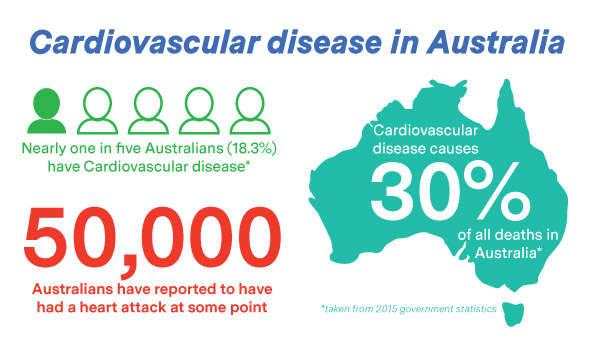What is cardiovascular disease?
The term cardiovascular disease refers to the group of diseases that affect the heart and blood vessels. Common examples include coronary heart disease, heart failure, peripheral vascular disease (eg. blood vessel disease in the legs), cardiomyopathy (disease of the heart muscle) and stroke. These diseases are all very serious and can be life threatening.1
Coronary heart disease, often referred to as ischaemic heart disease, is the most common heart disease in Australia. The two major forms of coronary heart disease are:1
- Heart attack: Often referred to as acute myocardial infarction, this occurs when the blood supply to the heart is completely blocked
- Angina: This is a chronic condition where chest pain occurs periodically as a result of temporary blockage of the blood supply to the heart. Whilst angina is not usually life-threatening itself, it is associated with an increased risk of heart attack

The burden of cardiovascular disease in Australia
Cardiovascular disease is the number one cause of death and disease burden in Australia. Nearly one in five Australians (18.3%) have cardiovascular disease which results in nearly 30% of all deaths in Australia (taken from 2015 government statistics). Nearly 500,000 Australians have reported to have had a heart attack at some point in their lives.1
Cardiovascular disease is undoubtedly one of Australis’s largest health problems and remains one of the biggest burdens on our health care system and economy.2
Cardiovascular disease: Identifying your risk
The risk factors associated with cardiovascular disease can be separated into non-modifiable risk factors (ie. things you can’t change), modifiable risk factors (ie. things you can do something about) and other health-related factors (such as other related chronic diseases).1
The major non-modifiable risk factors include:
- Advancing age1
- Genetics: Certain genes make individuals more susceptible1
- Ethnicity: For example, Aboriginal and Torres Strait Islander (ATSI) people have a higher rate of death from cardiovascular disease in Australia compared with non-ATSI people.2
Gender: Males generally have a higher risk than females. It is important to note that there are important gender differences in terms of how certain factors affect cardiovascular disease risk (ie. diabetes increases the risk of heart disease in females more than males)3
While we cannot do much about the risk factors above, there are certain lifestyle factors that we can control that play a major role in the development of cardiovascular disease. These are:1
- Smoking
- Not enough physical activity
- Poor diet
- Too much alcohol
If you would like help with any of the above lifestyle factors (and let’s face it, sometimes changing our behaviour can be very challenging), why not ask your doctor about how they can help? You and your doctor may decide to be referred to a dietitian, physical activity program and/or support services to help you quit or limit your smoking and alcohol consumption.
Other health-related factors are also very important risk factors for cardiovascular disease and should be managed simultaneously by you and your doctor. These include:1
- High blood pressure
- Diabetes
- High blood cholesterol
- Being overweight or obese
Cardiovascular disease risk: When to visit your doctor
If you are above the age of 45 (or above the age of 35 for ATSI person), it is strongly advised that you visit your GP to assess your risk of developing cardiovascular disease, even in the absence of any of the above risk factors.4
If you do have some of the above risk factors, it is recommended that you visit your GP regardless of age.4
|
Who? |
What? |
How often? |
|---|---|---|
|
Adults ≥ 45 years without known cardiovascular disease
|
Visit your GP to calculate your cardiovascular disease risk |
Every two years |
|
Aboriginal and Torres Strait islander peoples ≥ 35 years without known cardiovascular disease
|
Visit your GP to calculate your cardiovascular disease risk |
Every two years |
|
Adults with known cardiovascular risk factors and/or disease (regardless of age)
|
Visit your GP and/or specialist |
According to your personal management plan |
Your doctor will be able to organise and perform important procedures and tests – such as blood tests and blood pressure measurements – that will help to determine your absolute risk by using state-of-the-art risk calculators from the National Heart Foundation (or from similar reputable sources).4
While these calculators cannot predict the future with 100% certainty, they do provide a reasonably accurate guide as to how all of our risk factors (whether they be modifiable or non-modifiable) are affecting our cardiovascular disease risk. Sometimes this can provide just the motivation we need to create positive change in our lives for the sake of our health.
References
Australian Government Department of Health (online). Cardiovascular disease [accessed 5 Feb 2019]. Available from: URL link
Heart Foundation (online). Heart disease in Australia [accessed 6 Feb 2019]. Available from: URL link
Harvard Medical School (online). Gender matters: Heart disease risk in women [accessed 6 Feb 2019]. Available from: URL link
The Royal Australian College of General Practitioners. Guidelines for preventive activities in general practice. 9th edn, updated. East Melbourne, Vic: RACGP, 2018. Available from: URL link
All content and media on the HealthEngine Blog is created and published online for informational purposes only. It is not intended to be a substitute for professional medical advice and should not be relied on as health or personal advice. Always seek the guidance of your doctor or other qualified health professional with any questions you may have regarding your health or a medical condition. Never disregard the advice of a medical professional, or delay in seeking it because of something you have read on this Website. If you think you may have a medical emergency, call your doctor, go to the nearest hospital emergency department, or call the emergency services immediately.









